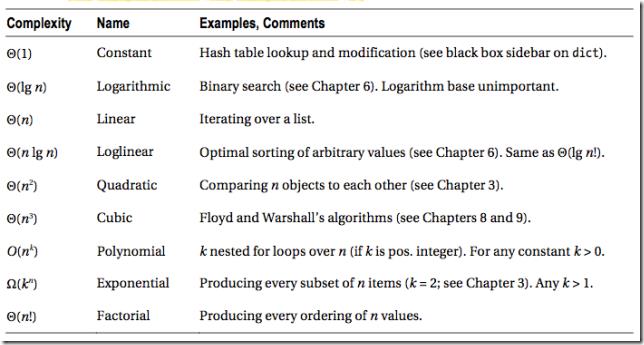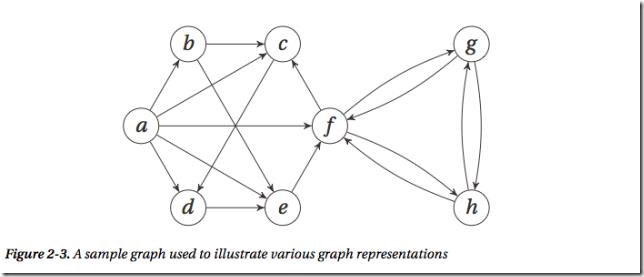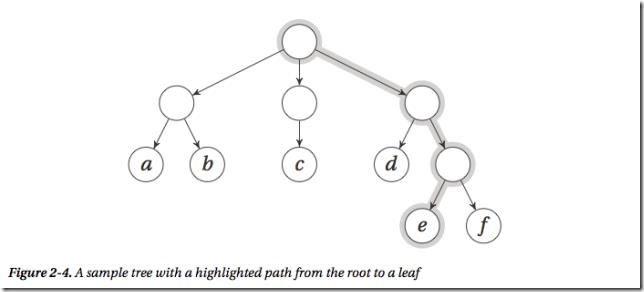Python Algorithms – chapter2 基础知识
Posted hqc
tags:
篇首语:本文由小常识网(cha138.com)小编为大家整理,主要介绍了Python Algorithms – chapter2 基础知识相关的知识,希望对你有一定的参考价值。
一、渐进记法
三个重要的记号
Ο、Ω、Θ,Ο记法表示渐进上界,Ω记法表示渐进下界,Θ记法同时提供了函数的上下界
几种常见的渐进运行时间实例
三种重要情况
最好的情况,最坏的情况,平均情况
最坏的情况通常是最有用的情况,可以对算法效率做出最佳保证
实证式算法评估
Tip1:If possible, don’t worry about it.
Tip2:用timeit模块进行计时
import timeit timeit.timeit("x = 2+2") #0.003288868749876883 timeit.timeit("x = sum(range(10))") #0.003288868749897271
Tip3:用profiler找出瓶颈
使用cProfiler获取运行情况的内容,打印出程序中各函数的计时结果,如果python版本中没有cProfiler可以使用profiler代替
import cProfile cProfile.run("helloworld()")
Tip4:绘制出结果
可以使用matplotlib绘制出结果,可参考http://www.cnblogs.com/huangqiancun/p/8379502.html
Tip5:在根据计时比对结果做出判断时要小心仔细
Tip6:通过相关实验对渐进时间做出判断时要小心仔细
二、图与树
1 图的实现
邻接表
邻接集
a, b, c, d, e, f, g, h = range(8) N = [ {b, c, d, e, f}, # a {c, e}, # b {d}, # c {e}, # d {f}, # e {c, g, h}, # f {f, h}, # g {f, g} # h ]
b in N[a] # True len(N[f]) # 3
邻接列表
a, b, c, d, e, f, g, h = range(8) N = [ [b,c,d,e,f], #a [c,e], #b [d], #c [e], #d [f], #e [c,g,h], #f [f,h], #g [f,g] #h ]
加权邻接字典
a, b, c, d, e, f, g, h = range(8) N = [ {b:2, c:1, d:3, e:9, f:4}, # a {c:4, e:3}, # b {d:8}, # c {e:7}, # d {f:5}, # e {c:2, g:2, h:2}, # f {f:1, h:6}, # g {f:9, g:8} # h ]
b in N[a] # True len(N[f]) # 3 N[a][b] # 2
邻接集的字典表示法
N = { \'a\': set(\'bcdef\'), \'b\': set(\'ce\'), \'c\': set(\'d\'), \'d\': set(\'e\'), \'e\': set(\'f\'), \'f\': set(\'cgh\'), \'g\': set(\'fh\'), \'h\': set(\'fg\') }
邻接矩阵
a, b, c, d, e, f, g, h = range(8) N = [[0,1,1,1,1,1,0,0], # a [0,0,1,0,1,0,0,0], # b [0,0,0,1,0,0,0,0], # c [0,0,0,0,1,0,0,0], # d [0,0,0,0,0,1,0,0], # e [0,0,1,0,0,0,1,1], # f [0,0,0,0,0,1,0,1], # g [0,0,0,0,0,1,1,0]] # h N[a][b] # Neighborhood membership -> 1 sum(N[f]) # Degree -> 3
对不存在的边赋予无限大权值的加权矩阵
a, b, c, d, e, f, g, h = range(8) _ = float(\'inf\') W = [[0,2,1,3,9,4,_,_], # a [_,0,4,_,3,_,_,_], # b [_,_,0,8,_,_,_,_], # c [_,_,_,0,7,_,_,_], # d [_,_,_,_,0,5,_,_], # e [_,_,2,_,_,0,2,2], # f [_,_,_,_,_,1,0,6], # g [_,_,_,_,_,9,8,0]] # h W[a][b] < inf # True sum(1 for w in W[a] if w < inf) - 1 # 5
注意:在对度值求和时务必要记得从中减1,因为我们不想把对角线也计算在内
Numpy库中的专用数组
N = [[0]*10 for i in range(10)]
import numpy as np N = np.zeros([10,10])
更多内容可参考http://www.cnblogs.com/huangqiancun/p/8379241.html
2 树的实现
T = [["a", "b"], ["c"], ["d", ["e","f"]]] T[0][1] # \'b\' T[2][1][0] # \'e\'
二叉树类
class Tree: def __init__(self, left, right): self.left = left self.right = right t = Tree(Tree("a", "b"), Tree("c", "d")) t.right.left # \'c\'
多路搜索树类(左孩子,右兄弟)
class Tree: def __init__(self, kids, next=None): self.kids = self.val = kids self.next = next return Tree t = Tree(Tree("a", Tree("b", Tree("c", Tree("d"))))) t.kids.next.next.val # \'c\'
Bunch模式
bunch类
class Bunch(dict): def __init__(self, *args, **kwds): super(Bunch, self).__init__(*args, **kwds) self.__dict__ = self
x = Bunch(name = "Jayne Cobb", position = "Public Relations") x.name #\'Jayne Cobb\'
T = Bunch t = T(left = T(left = "a",right = "b"), right = T(left = "c")) t.left # {\'right\': \'b\', \'left\': \'a\'} t.left.right #\' b\' "left" in t.right # True
三、黑盒子
1 隐性平方级操作
from random import randrange L = [randrange(10000) for i in range(1000)] 42 in L # False S = set(L) 42 in S #False
看起来使用set毫无意义,但是成员查询在list中是线性级的,在set中则是常数级的
lists = [[1,2], [3,4,5], [6]] sum(lists, []) #[1, 2, 3, 4, 5, 6] res = [] for lst in lists: res.extend(lst) # [1, 2, 3, 4, 5, 6]
sum函数是平方级的运行时间,第二个为更好的选择,当list的长度很短时,他们之间没有太大差距,但一旦超出某个长度,sum版本就会彻底完败
2 浮点运算的麻烦
sum(0.1 for i in range(10)) == 1.0 #False
def almost_equal(x, y, places=7): return round(abs(x-y), places) == 0 almost_equal(sum(0.1 for i in range(10)), 1.0) # True
from decimal import * sum(Decimal("0.1") for i in range(10)) == Decimal("1.0") #True
以上是关于Python Algorithms – chapter2 基础知识的主要内容,如果未能解决你的问题,请参考以下文章


